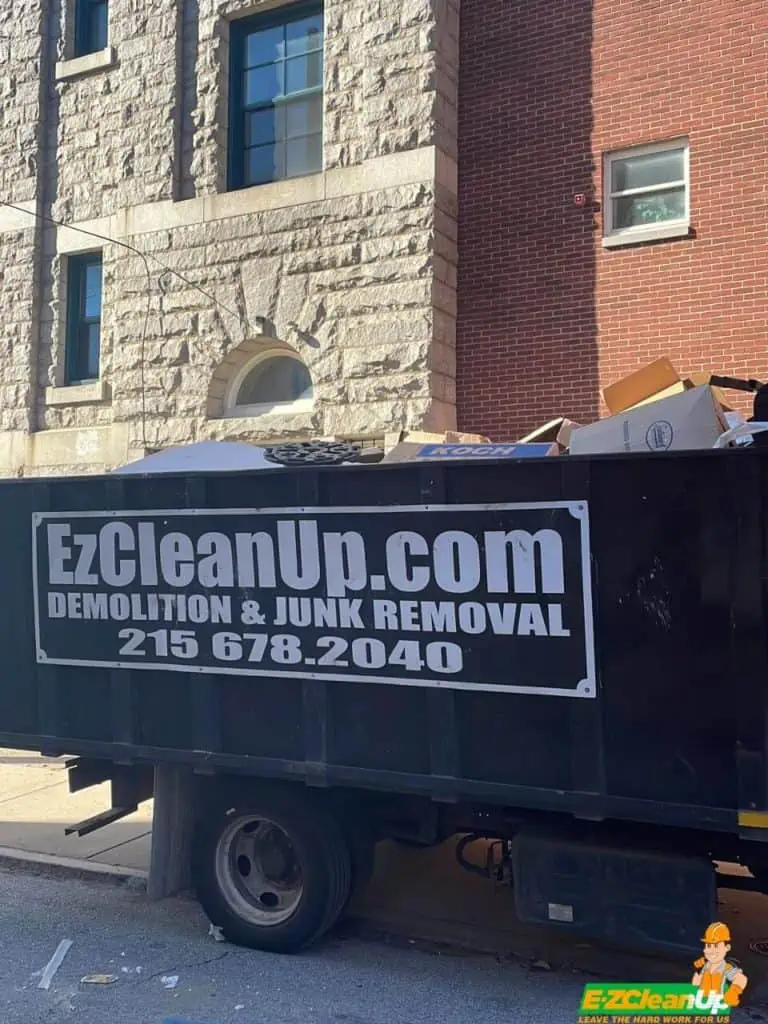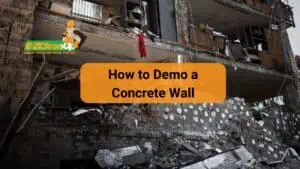This article explores the reasons for demolition, the different types of demolition, and when each type is needed. By the end of this article, you will understand the circumstances that necessitate demolition and how our demolition services can help.
What are the types of demolition?
There are three primary types of demolition:
🏗️ Entire Building Demolition
Entire building demolition is the process of completely removing a building or structure from a property. This type of demolition is often required when a building is beyond repair or when there are plans for new construction on the property. Heavy machinery, such as wrecking balls and hydraulic excavators, is used to tear down the structure, making way for a fresh start.

🔧 Selective Demolition (Deconstruction)
Selective demolition, also known as deconstruction, involves the careful removal of specific parts of a building while preserving the remaining structure. This type of demolition is often employed during renovation projects or when a building needs to be modified for a new purpose. The primary goal of selective demolition is to recover valuable components and materials for reuse or recycling, making it a more sustainable and eco-friendly option compared to other demolition methods.

🛋️ Interior Demolition
Interior demolition focuses on removing the interior components of a building, such as walls, ceilings, and flooring. This type of demolition is typically carried out during major renovation projects or when the interior layout of a building needs to be reconfigured to better suit the occupants’ needs. Interior demolition can also be necessary when a building is being repurposed, such as converting an old warehouse into a modern office space. This process often involves the use of specialized tools and equipment to ensure minimal damage to the remaining structure and prevent any potential safety hazards.

When is an entire building demolition needed?
Entire building demolition is needed when the structure is beyond repair, unsafe, or when the property owner has plans for new construction. Let’s explore the situations that necessitate entire building demolition in more detail:
🏚️ When the building is too old
Older buildings can pose safety risks and incur high maintenance costs due to outdated construction materials, electrical systems, and plumbing. In such cases, demolishing the entire structure and building a new one can be more cost-effective and safer in the long run.
⚠️ When the foundation is damaged
A damaged foundation can compromise the structural integrity of a building, posing significant safety risks. When the foundation is beyond repair, an entire building demolition may be the only viable solution to prevent potential accidents and ensure the safety of the occupants.
💰 When you want to sell the property
In some cases, the land may be more valuable without the existing structure, especially in prime locations where real estate is in high demand. An entire building demolition can increase the property’s value and make it more attractive to potential buyers.
🏗️ When you wish to build from scratch
If a property owner has plans to build a new structure that better meets their needs and preferences, an entire building demolition may be required to clear the site and make way for new construction.
🔝 When you want to enhance the value
Demolishing an old, dilapidated building and constructing a new one can significantly enhance the overall value of a property. This can be particularly beneficial in areas where land values are high, and modern, functional structures are in demand.

When is selective demolition an option?
Selective demolition, also known as deconstruction, is an option when specific parts of a building need to be removed or modified while preserving the remaining structure. Here are some common scenarios where selective demolition is the preferred choice:
- 🏠 Renovation projects: Homeowners or property managers might want to remodel specific areas of their property, such as kitchens, bathrooms, or living spaces. Selective demolition allows them to remove only the necessary parts without affecting the rest of the building.
- ♻️ Sustainability goals: Selective demolition enables the recovery and recycling of valuable building materials, reducing waste and environmental impact. By choosing this method, property owners can contribute to a more sustainable construction industry.
- 🏢 Building repurposing: In cases where a building is being repurposed for a new function, such as converting a warehouse into residential lofts or an office building into a hotel, selective demolition can be employed to modify the structure according to its new purpose.
- 🔧 Structural modifications: If a building requires modifications to its structural components, such as adding or removing walls, beams, or columns, selective demolition allows for precise alterations without causing unnecessary damage to the rest of the structure.
- 🌐 Preservation of historical or architectural features: Selective demolition is ideal for preserving historically or architecturally significant elements of a building. In cases where the building has unique or valuable features that need to be retained, selective demolition ensures that these elements are not damaged during the process.
- 🕒 Time and cost efficiency: In some instances, selective demolition can be more time and cost-effective compared to a complete teardown. By focusing on specific areas or components, the demolition process can be streamlined, and the overall project timeline can be shortened.
- 🏙️ Urban settings: In densely populated urban areas, selective demolition is often a more practical option as it minimizes disruptions to neighboring properties and reduces the overall impact on the surrounding community.
In summary, selective demolition is an ideal choice when specific parts of a building need to be removed or modified while preserving the remaining structure. It offers flexibility, sustainability, and efficiency, making it a popular choice for various types of projects.

When does an interior demolition is needed?
Interior demolition involves the removal of interior parts of a building, such as walls, ceilings, and flooring, without affecting the overall structure. It is typically required in the following situations:
- 🏠 Major renovations: Homeowners and property managers often opt for interior demolition when undertaking significant renovation projects. This process allows them to create a blank canvas for redesigning and updating interior spaces according to their preferences and requirements.
- 🏢 Change of building use: When a building is being repurposed, such as converting a warehouse into residential lofts or an office building into a hotel, interior demolition can help adapt the space to its new function. This process involves removing non-essential components and reconfiguring the layout to accommodate the building’s new purpose.
- 🛠️ Structural alterations: If a building requires modifications to its interior layout, such as adding or removing walls or creating new doorways, interior demolition can facilitate these changes without affecting the exterior structure.
- 💧 Damage repair: In cases where a building has suffered extensive interior damage due to flooding, fire, or other disasters, interior demolition may be necessary to remove damaged components and prepare the space for restoration.
- 🚧 Building code compliance: If a building is found to be non-compliant with current building codes, interior demolition may be required to remove non-compliant elements and make necessary modifications to meet safety and accessibility standards.
- 🤝 Tenant customization: Property owners may need to perform interior demolition when a new tenant moves in and requires specific customizations to the space. This can involve removing existing walls, ceilings, or flooring, as well as any other parts that need to be updated or changed to meet the new tenant’s requirements.
- ⚡️ Upgrading infrastructure: Buildings with outdated electrical, plumbing, or HVAC systems may require interior demolition to allow for the installation of modern, energy-efficient systems. This can improve the building’s overall efficiency and functionality, as well as reduce maintenance costs and energy consumption.
In summary, interior demolition is needed when light-to-major renovations, changes in building use, structural alterations, damage repairs, code compliance, tenant customization, or infrastructure upgrades are required. It provides a targeted and efficient approach to modifying a building’s interior without affecting its overall structure.

Comparison of Demolition Types: Scenarios and Benefits
| Type of Demolition | Scenario | Benefits |
| Entire Building | – Building is too old – Foundation is damaged – Selling property – Building from scratch | – Complete removal of structure – Increased property value – Opportunity for new construction |
| Selective | – Renovation projects – Sustainability goals – Building repurposing – Structural modifications | – Preservation of remaining structure – Recycling and reusing materials – Targeted alterations |
| Interior | – Major renovations – Change of building use – Structural alterations – Damage repair – Building code compliance – Tenant customization – Upgrading infrastructure | – Modification of interior spaces – Maintaining exterior structure – Adapting to new uses or requirements |
EZ Cleanup Demolition Services
In conclusion, demolition projects come in various forms, from entire building demolitions to selective and interior demolitions. Each type serves specific needs, depending on factors such as the building’s age, structural integrity, renovation requirements, or repurposing goals. Understanding the reasons for demolition and choosing the appropriate method is essential to ensure a successful outcome.
EZ Cleanup is a professional demolition company with years of experience in handling all types of demolition projects. Our team of experts is skilled at assessing the unique needs of each project and employing the most suitable demolition techniques. With a strong focus on safety, efficiency, and environmental responsibility, EZ Cleanup is the go-to choice for all your demolition needs.

Don’t wait any longer to start your demolition project! Contact EZ Cleanup today at (215) 678-2040 for a free consultation and let our experienced team help you achieve your goals!














